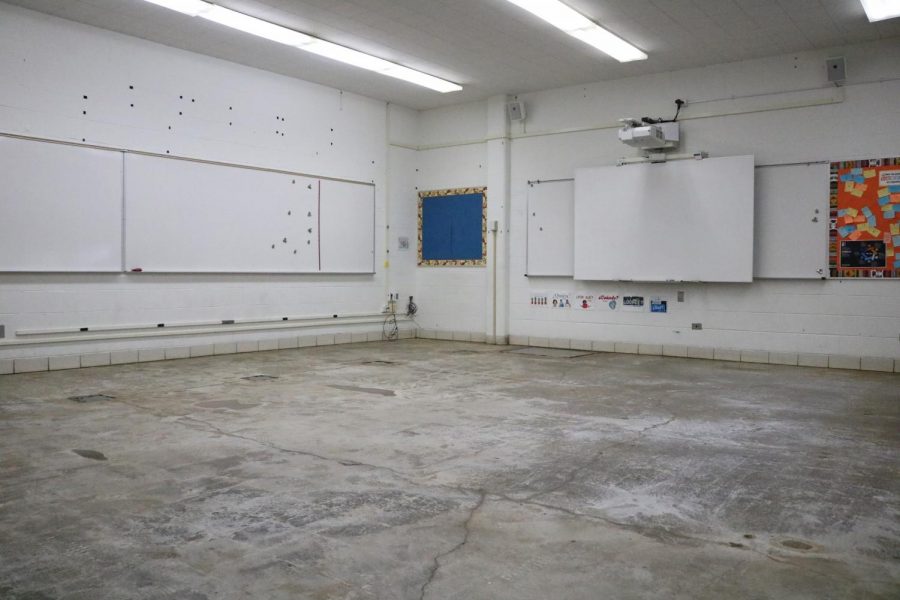Asbestos, lead removed recently
Room 130 is one of the foreign language classrooms where asbestos was found under the floor tiles. The asbestos was discovered in early April; the classrooms are expected to ready to use on May 20.
Libertyville High School is working to eliminate certain building-wide issues that have arisen recently, such as the presence of asbestos and lead paint, as well as update the heating and air conditioning systems. The renovation of these issues has begun and there are various dates for when specific updates will be completed.
In early April, asbestos was found under the floor tiles of classrooms 128 and 130, which are both foreign language classrooms. Building and Grounds immediately investigated to find the best solution and decided to temporarily close the two classrooms so the work to abate asbestos could be completed as soon as possible. Rooms 128 and 130 are expected to be cleared for learning May 20, the last day of classes this semester, according to Mr. Mark Koopman, the district’s Building and Grounds director.
Asbestos, a natural mineral, is particularly present in structures built before 1980 — mostly in old floor tiles, ceiling tiles, roof shingles and insulation — although there may be asbestos in new buildings as well. It is particularly an issue at LHS, since the gym was built with asbestos around 1954 and has undergone various additions that also utilized asbestos. With heavy asbestos exposure, people’s lungs can be scarred, causing issues such as shortness of breath, and it can even be lethal in severe cases, according to the Health and Safety Executive.
“Our plan is to keep moving on and remove the asbestos in the building to create an asbestos-free environment,” stated Mr. Koopman. Over the years, he mentioned, asbestos has been a recurring issue at LHS that the team is working to remove, though for the most part, it is encapsulated and therefore not a threat to students and faculty.
Mr. Koopman added that information on asbestos removal is available on the building and district websites. They are also sure to give a 10-day notification to faculty and students, then schedule work, followed by work at night when classes are not in session, though people can be in the building while the asbestos is abated.
Currently, many students taking Spanish are in one of the innovation rooms, 149, while the asbestos is removed.
Spanish teacher Mrs. Elaine Schreck, who teaches in one of the affected rooms, appreciated the fast response to the work order she put in when she first suspected her room had asbestos in the floor tiles.
“I think I put in a work order fifth period [and] by sixth period, they were in my classroom,” she said. “Right away they took precautions to make sure that we weren’t going to be in that room with tiles falling off the floor.”
Students who were moved to the innovation room had a mostly seamless transition from the Spanish room.
“I kind of like [being in the innovation room] just because all my other classrooms [have] the standard desks and rows and are just kind of boring, and I like [the innovation room] because it has the high chairs and cool tables,” mentioned junior Lexie Hille.
The innovation room was updated recently and facilitates group work and collaboration.
“I like having the extra screens that you wouldn’t find in a normal classroom, so it’s more flexible [overall],” added Mrs. Schreck. She noted that it was an adjustment at first, but for the most part, her students appreciate the room.
The work to abate asbestos in rooms 128 and 130 was preceded by the removal of chipped lead paint from the ceiling in the main gym.
Much like the presence of asbestos in language classrooms, the lead paint issue was addressed quickly; work on that issue finished shortly after spring break. During this time, the gym was closed for nearly three weeks. Several sports teams, as a result, found other venues and/or had shortened practices. For example, the badminton teams used space at VHHS and gym classes combined and participated in a bowling unit in order to stay active during the work on the main gym.
Mr. Koopman clarified that the lead paint was not harmful unless it was ingested.
In addition to these issues, Building and Grounds will soon continue its work of updating the ventilation systems in the school, which started last summer and is set to continue the upcoming summer to fully improve each floor of LHS.
According to Mr. Koopman, the Building and Grounds department was able to renovate the second floor heating and air conditioning units last summer. It was useful that summer school was at Vernon Hills High School instead of LHS so workers didn’t have to accommodate for classes in session.
This upcoming summer, Mr. Koopman and the Building and Grounds team is planning to update the heating and air conditioning units on the first floor. He is collaborating with the team at LHS to plan how they will make changes to permanently benefit the units and keep them from needing even more updates in the near future.
In total, Mr. Koopman estimates $2 million will be spent this summer on the renovation of ventilation units.
For all issues the weathered LHS building has to face, Mr. Koopman noted Building and Grounds is diligent in their handling of the problems: “Our goal … is to provide a safe and clean learning environment for staff, students and any guests in the building.”





![Mr. Abullh Ali, manager/assistant, helps open Queen Yemeni Coffee in downtown Libertyville at 606 North Milwaukee Ave. With the help of employees such as manager and LHS senior Yousef Taha, they are able to bring the Yemeni and Ethiopian culture to Libertyville by using their Queen spices, cinnamon and cardamom in their drinks such as Adani Chai, which is inspired by Sheda, the Queen of Yemen and Ethiopia. “The history of our coffee [is] a long history and we believe that Yemen and Ethiopia started the coffee and we are bringing something unique to the community,” Mr. Ali said.](https://www.lhsdoi.com/wp-content/uploads/2025/04/Photo-1-600x400.jpg)



